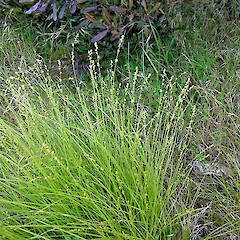Carex divulsa
Common name
grey sedge
Family
Cyperaceae
Flora category
Vascular – Exotic
Structural class
Sedges
NVS code
The National Vegetation Survey (NVS) Databank is a physical archive and electronic databank containing records of over 94,000 vegetation survey plots - including data from over 19,000 permanent plots. NVS maintains a standard set of species code abbreviations that correspond to standard scientific plant names from the Ngä Tipu o Aotearoa - New Zealand Plants database.
CARDIV
Conservation status
Not applicable
Brief description
Dense grass-like, dark green tussock, up to 50 cm tall, with longer flower spikes, the spikes are made up of small groups of small green flowers on a thin arching stem. (Despite its common name, plants in NZ are mid-green to yellow green, not grey.)
Distribution
Scattered throughout the North Island and Nelson, Marlborough and Canterbury; Chatham Islands.
Habitat
Widespread from the coast to subalpine situations. Usually found as a pasture and lawn weed with a distinct preference for calcareous or other base-rich substrates. Will colonise forest especially forest margins and gaps. A serious weed in native vegetation.
Wetland plant indicator status rating
Information derived from the revised national wetland plant list prepared to assist councils in delineating and monitoring wetlands (Clarkson et al., 2021 Manaaki Whenua – Landcare Research Contract Report LC3975 for Hawke’s Bay Regional Council). The national plant list categorises plants by the extent to which they are found in wetlands and not ‘drylands’. The indicator status ratings are OBL (obligate wetland), FACW (facultative wetland), FAC (facultative), FACU (facultative upland), and UPL (obligate upland). If you have suggestions for the Wetland Indicator Status Rating, please contact: [Enable JavaScript to view protected content]
FAC: Facultative
Commonly occurs as either a hydrophyte or non-hydrophyte (non-wetlands).
Detailed description
Dense, dark-green to yellow-green, deeply rooted grass-like tussock-forming sedge. Rhizome thick, short, ascending with dark brown scales soon becoming fibrous. Stems 0.15–1.8 m high, slender and wiry, 3-angled, scabrid on angles. Leaves 2–3 mm wide, < stems, flat to channelled, rather harshly scabrid, sheaths dull, light creamy-brown. Inflorescence 50–120 mm long, often with 1–2 very short branches at base; spikes ± 10, sessile, light green, distant below, 3–5 uppermost more crowded; bracts filiform. Spikes few-flowered, androgynous, male flowers at top. Glumes much < utricles, ovate, acuminate, colourless-hyaline with a green midrib. Utricles 4–5 × ± 2 mm, ovate, plano-convex, nerveless, light brown, tapering to a short bifid beak with scabrid margins, stipe minute. Stigmas 2. Nut obovoid, biconvex.
Similar taxa
The mixed-sex flower spikes resemble those of the native C. virgata and C. secta, but C. divulsa is much smaller and the leaf margins are not cutting.
Flowering
Late spring
Flower colours
Brown, Green
Fruiting
Summer
Life cycle
Long-lived perennial sedge. Seed dispersed by contaminated machinery or garden discards.
Year naturalised
1883
Origin
Europe, North Asia, North Africa
Reason for introduction
Ornamental plant
Control techniques
Not difficult to hand-pull - take the plants (or at least the seed heads) away and destroy them. Not often controlled in New Zealand.
Tolerances
Cold and drought tolerant—can tolerate a wide range of soils types.
Etymology
carex: Latin name for a species of sedge, now applied to the whole group.
Attribution
Factsheet prepared by Paul Champion and Deborah Hofstra (NIWA).
References and further reading
Champion P. et al. 2020. Freshwater Invasive Species of New Zealand 2020. NIWA publication. https://docs.niwa.co.nz/library/public/FreInSpec.pdf
Healy AJ, Edgar E. 1980. Flora of New Zealand, Volume III. Adventive Cyperaceous, Petalous and Spathaceous Monocotyledons. Government Printer, Wellington, NZ. 220 p.
Johnson PN, Brooke PA. 1989. Wetland plants in New Zealand. DSIR Field Guide, DSIR Publishing, Wellington, NZ. 319 p.











